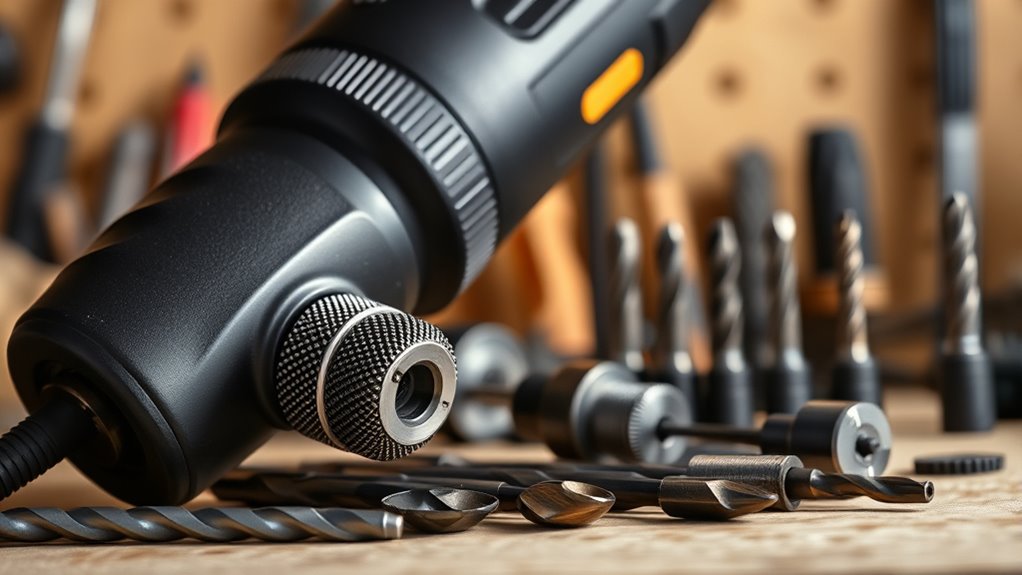To choose the right power drill for DIY projects, consider the type of tasks you’ll do most often—light tasks need a lower voltage, while heavier jobs call for an 18V or higher model with more torque. Think about the drill’s features like variable speed, chuck size, and whether you prefer corded or cordless design. Ergonomics and battery life also matter for comfort and efficiency. Keep exploring to find the perfect match for your DIY needs.
Key Takeaways
- Consider the type of drill (e.g., basic, hammer, impact) based on your DIY tasks and material requirements.
- Choose the appropriate power source and voltage for your projects, balancing power needs and portability.
- Opt for variable speed controls for precision and versatility across different materials and applications.
- Select a chuck type and size that match your bits and project complexity for quick, secure bit changes.
- Prioritize ergonomic design, lightweight construction, and battery life for comfortable, prolonged use during DIY tasks.

Are you unsure which power drill is right for your project? With so many options available, selecting the right tool can seem overwhelming. First, consider the types of drills suited for your needs. Basic power drills are versatile and perfect for household tasks and DIY projects. They handle drilling holes and driving screws with ease. If you’re working on tougher surfaces like brick or concrete, a hammer drill is your best bet. It combines rotary motion with a forward hammering action, making masonry work much easier. Many models let you disable the hammer mode if you only need a standard drill, giving you flexibility.
If space is limited or you need to work in tight spots, a right-angle drill is invaluable. Its chuck sits at a 90-degree angle, enabling you to drill in confined areas where a regular drill won’t fit. For driving large fasteners or when you need more torque, impact drivers are the way to go. They deliver higher torque than standard drills and use quick-change bits, making heavy-duty fastening tasks more manageable. Both corded and cordless impact drills exist—cordless models offer portability, but impact drills tend to provide more torque and feature variable speed controls, which helps you fine-tune your work.
Power and voltage are essential factors. Higher voltage drills, typically in the 18V to 20V range, provide more power for demanding projects, but they often come with heavier batteries. If you’re tackling lighter tasks, a 12V drill may be sufficient and easier to handle. Corded drills, which run directly on electricity, supply consistent power without battery concerns, but they limit your mobility. Motor wattage and torque ratings also matter; higher ratings mean better performance for tougher materials. A crucial aspect of modern projectors is the inclusion of features like variable speed and adjustable torque settings, which can also be valuable in selecting the right power drill.
Speed control is another key feature. Variable speed allows you to adjust the drill’s RPM, helping you start slow to prevent slipping and then speed up for efficiency. Impact drills often have multiple speed modes, increasing versatility across various materials. Precise speed regulation reduces damage to work surfaces and improves the quality of your results.
The drill’s chuck type and size influence ease of bit changes and compatibility. Keyless chucks let you swap bits quickly without tools, ideal for frequent changes, while keyed chucks provide a more secure grip. Common sizes like 10mm or 13mm determine the maximum bit diameter, with larger sizes suitable for heavy-duty jobs.
Finally, consider ergonomics and weight. Lightweight, well-balanced drills reduce fatigue, especially during extended use. An ergonomic grip and compact design help you work comfortably in tight spaces. Battery life is essential for cordless models; lithium-ion batteries offer longer runtimes and are lighter, making your work more efficient. Match your choice to your project scope, comfort, and budget, and you’ll find the perfect power drill to tackle any DIY task with confidence.
Frequently Asked Questions
What Is the Average Battery Life for Cordless Drills?
The average battery life for cordless drills is like a battery-powered heartbeat—consistent but varying. Typically, you can expect 1-2 hours of runtime on a full charge for standard models, enough for most DIY tasks. High-end drills may last longer, especially with light use, while compact models might need more frequent recharging. Proper maintenance and choosing batteries with higher Ah ratings can help extend your drill’s working time.
How Heavy Should a Power Drill Be for Prolonged Use?
You should look for a power drill that feels comfortable and manageable for prolonged use, ideally weighing around 3 to 4 pounds. Lighter drills reduce fatigue, improve maneuverability, and let you work longer without discomfort. Choose a balanced design with ergonomic handles to help distribute the weight evenly. Keep in mind your strength and task requirements, selecting a drill that offers a good mix of power and lightweight handling for extended projects.
Are There Safety Features I Should Look For?
Imagine you’re about to start a project when you realize your drill has a tight chuck mechanism. That safety feature keeps bits secure, preventing accidents. When choosing a power drill, look for features like a secure chuck, ergonomic handles, and overheat protection. These guarantee your safety during use. Always wear goggles and gloves, and keep your workspace protected. Prioritizing safety features helps you avoid injuries and makes your DIY experience smoother.
Can I Use a Drill for Woodworking and Metalworking?
You can definitely use a drill for both woodworking and metalworking. Just keep in mind, for woodworking, a versatile rotary or cordless drill with lower power and adjustable speed works well. For metalworking, choose a more powerful drill with higher torque, proper cooling, and suitable bits. Switching between different bits and adjusting settings guarantees ideal performance and safety for each material.
What Maintenance Does a Power Drill Require?
Think of your power drill as a trusted partner that needs caring. You should regularly clean it to keep dust away, lubricate moving parts to reduce friction, and check for damage on cables, switches, and bits. Conduct inspections to catch issues early, store it properly in a dry place, and address repairs promptly. Proper maintenance keeps your drill running smoothly, extending its life and ensuring safe, efficient DIY projects every time.
Conclusion
Now that you know what to look for, choosing the right power drill becomes a breeze. Remember, the perfect drill can turn your DIY projects from mere hobbies into epic masterpieces—like wielding a magic wand in your hands! So, pick one that feels right, matches your needs, and sparks your confidence. With the right drill, you’ll conquer any task and create wonders you never thought possible. Happy drilling—your DIY empire awaits!










